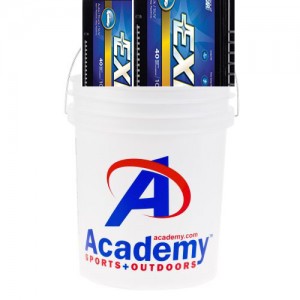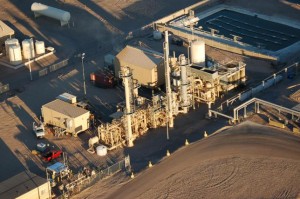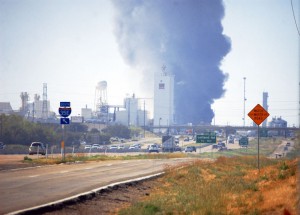air toxics
Ask the State and Holcim To Finally Give DFW “the Holy Grail” of Cement Pollution Control Technology
 Swiss-based Holcim Cement is requesting a permit amendment to add new piece of pollution control equipment to its Midlothian cement plant, one of three cement plants that make the city the "Cement Capitol of Texas" and the largest concentration of cement manufacturing in the U.S. Good news, right? The problem is that the company is asking the state for the permit before deciding what kind of pollution control equipment to install.
Swiss-based Holcim Cement is requesting a permit amendment to add new piece of pollution control equipment to its Midlothian cement plant, one of three cement plants that make the city the "Cement Capitol of Texas" and the largest concentration of cement manufacturing in the U.S. Good news, right? The problem is that the company is asking the state for the permit before deciding what kind of pollution control equipment to install.
That's right. Holcim is asking the Texas Commission on Environmental Quality (TCEQ) to OK a permit that will result in a "major modification" of its Midlothian plant and could produce significant amounts of new pollution before it even decides what the major modification is going to be. Anywhere else in the country this might be a bit odd, but hey, it's Texas, where Rick Perry's TCEQ has a rubber stamp standing by for anything industry requests.
Holcim's permit request is being prompted by a problem complying with new federal regulations limiting a kind of pollution called Total Hydrocarbons, or THCs. These are also sometimes referred to as "Volatile Organic Compounds." Think Benzene, and other kinds of hazardous flammable gases. In its permit application Holcim says it needs to add new controls to reduce THC to levels and come under the new federal standard. Fair enough. The company then says that it's still trying to decide between two different types of controls and will make up its mind after getting the permit and seeing how well its choice works out on one of its two separate giant kilns. That's the bogus part.
But wait, there's more! The two technologies Holcim is considering installing in Midlothian are: 1) A Regenerative Thermal Oxidizer, or RTO, which is a fancy way of saying setting them on fire and flaring them off, and, 2) A Selective Catalytic Reduction unit, or SCR, which is a tower of treated metal honeycombs that pick up pollution as the plant exhaust passes through them. RTOs are already installed on American cement plants, including TXI's huge Midlothian kiln just a few miles down Highway 67 from Holcim. On the other hand, up to now full-scale commercial SCR units have only been installed on European cement plants and in fact, the Portland Cement Association has lobbied long and hard to keep them out of the US for fear of raising the pollution control bar too high for all of the country's cement plants.
That's because SCR is more expensive to build and maintain than most cement plant control devices. But for the money, you get the Holy Grail of cement plant pollution control technology.
Most of the European cement plants that have SCR units install them to remove another type of pollution from their stacks – Nitrogen Oxides (NOx). If that sounds familiar, it's because NOx is a major smog-forming pollutant, and DFW has so much of it that the region has never been in compliance with the Clean Air Act standard for smog. And you'll never guess which facilities are the single largest sources of NOx pollution in North Texas. Or maybe you will: the Midlothian cement plants. That's why Downwinders at Risk has made it a point to campaign to require all three Midlothian cement plants – Holcim, TXI and Ash Grove – to install SCR….since all the way back in 2001, when the first European units were deemed a success at a German cement plant. SCR can remove 80 to more than 90% of all NOx coming out of a cement kiln. The 6500 tons of NOx a year that the Midlothian cement plants are permitted to release could be reduced to 650 tons with the application of SCR.
Now, as it turns out, SCR units are great not only at capturing large amounts of NOx pollution, but all kinds of other industrial pollution coming out of cement plants as well. Like THCs – up to 70% or so, but also Particulate Matter, Metals, Greenhouse Gases, Carbon Monoxide, and Dioxins. It's what's called a multi-pollutant control device because it does such a good job of eliminating a wide variety of nasty stuff from smoke stacks. This is what makes it the state-of-the-art technology for communities hosting kilns. In contrast, RTOs are single-purpose pollution devices aimed just at hydrocarbon removal and aren't designed to remove other kinds of emissions.
So even though Holcim is considering operating SCR because of its hydrocarbon problem, it would have a massive impact on the plant's air pollution across the board. And if Holcim were to set the precedent, the clock would begin ticking on bringing SCR to the other two Midlothian cement plants as well. It would only be a matter of time.
The public comment period for telling the state whether to accept or reject Holcim's permit application ends this Friday, July 11th at 5 pm. (If you're interested in jumping through the hoops to fill out the online form for official comments, you can go here and use Permit Number 8996)
Downwinders is submitting detailed comments praising Holcim for considering SCR, but urging the TCEQ to reject this permit because it's too vague and doesn't commit the company to any partciular technology, including SCR. We've also been collecting letters form local officials and stare legislators that urge Holcim to definitively choose SCR.
Now we're asking you to help us bombard both the Texas Commission on Environmental Quality and Holcim's US headquarters in Dundee Michigan in the next 48 hours with the same message to show public support for the company to do the right thing while rejecting a placeholder permit that doesn't commit it to do that right thing.
We want a permit request from the company that says Holcim will definitely install SCR, becoming the first commercial application of this state-of-the-art technology in America.
Using our "Featured Citizen Action" link, you can send such a message to Austin and Michigan in a matter of seconds right now. All you have to do is click here and then send the e-mails. We guarantee there's no more important or easier thing you can do for clean air in North Texas this week than sending these e-mails to the TCEQ Commisisoners and Holcim Corporate leadership. Please help us get the cement plant pollution control technology DFW deserves. It will only take a matter of seconds for you to help us achieve a goal we've been working toward for 14 years. We can do this. But we need your help. Now. Thanks.
Study: LAX Pollutes More Than Half of SoCal Freeways
 Researchers at the Keck School of Medicine and the University of Southern California have just published a report in the American Chemical Society's Environmental Science & Technology journal that shows air traffic from Los Angeles International Airport is responsible for more air pollution than half of all the city's notoriously congested freeways with a plume extending at least 10 miles downwind.
Researchers at the Keck School of Medicine and the University of Southern California have just published a report in the American Chemical Society's Environmental Science & Technology journal that shows air traffic from Los Angeles International Airport is responsible for more air pollution than half of all the city's notoriously congested freeways with a plume extending at least 10 miles downwind.
LAX is the world's sixth largest airport, with 40-60 take-offs an hour. DFW averages 46 according to the airport's own website.
USC Scientists spent a month driving around the LA airport taking air samples for Particulate Mater pollution and found that downwind communities had twice the routine background level of PM in the city. Nine miles out, they found PM levels five times higher than background. Two miles from LAX, PM levels were almost 10 times higher. For comparison's sake, that's equivalent to 174 to 491 miles of freeway traffic. The entire area of Los Angeles County has a total of about 930 miles of freeways. Based on their calculations, scientists concluded that within the area they found to have elevated pollution from the airport, automobiles contributed less than 5 percent of the PN levels. “Therefore, the LAX should be considered one of the most important sources of PN in Los Angeles,” concluded the ACS piece
Why is that a public health concern?
"Ultrafine particles, which form from condensation of hot exhaust vapors, are of particular concern because they deposit deeply into the lungs and can enter the bloodstream. The oxidative stress and resulting inflammation appear to play a role in the development of atherosclerosis (blocked arteries) and can make other health conditions worse, especially for people with existing cardiac or lung conditions including asthma."
As far as we know there's been no study of PM pollution from DFW Airport – no federal highways dollars at stake – but this one from California should prompt one.
Have You Seen This Bucket of Hazardous Waste ?
 It's 2014. Distant parts of the globe are connected within micro seconds. Some of us are driving electric cars. Our phones are more powerful than all the computers it ever took to put a human being on the Moon, combined.
It's 2014. Distant parts of the globe are connected within micro seconds. Some of us are driving electric cars. Our phones are more powerful than all the computers it ever took to put a human being on the Moon, combined.
And we use five gallon buckets from Academy to collect and store industrial hazardous waste.
Or at least the Exide contractors that are in charge of "cleaning-up" Frisco's Stewart Creek do. And they not only use them, they lose them.
On May 8th, workers for Apex-Titan Inc. were collecting battery casing chips and bits of lead slag from fields near the Creek a the intersection of Legacy and Stonebrook and putting them into the bucket. For decades before it closed in 2012, the Exide lead smelter dumped waste into and around the Creek, leaving a still-contaminated trail from the plant site all the way to Lake Lewisiville, approximately five miles away.
After collecting a full load of Exide waste, the contractors placed the bucket in the back of a pick-up truck and drove off – apparently without securing the tailgate first. Despite two staff from the Texas Commission on Environmental Quality on the scene to "document field activities" and the City of Frisco's own contractor present – nine people in all – no one noticed when or how the bucket fell off the truck on he way back to the plant site.
When they discovered the loss, the workers retraced their route. They searched the parking lot of a city park located across the street from a school – one of two in the immediate vicinity. No bucket. More than two weeks later the bucket of hazardous waste is still missing. But we're only now finding out about it.
This would be funny if it weren't for the possibility of this bucket ending up with kids or in a garden or as a water container. As a memo from the City of Frisco puts it:
"We believe it is a reasonable assumption that the bucket was found in the street by a person who picked it up for their own use; without realizing the contents might be hazardous waste."
With that in mind, did the City of Frisco inform the Frisco School District? Did any warnings get issued to students and parents at the two near-by schools? Not as far as we know. Did the City put out an All Points Bulletin for the bucket? No it did not. Embarrassment often keeps officials from doing the right thing about public health. So there's hazardous lead waste out there in a Frisco neighborhood that could be diminishing kids' IQs even as you're reading this, even as officials are too embarrassed to ring the alarm.
Now maybe you're thinking this whole Frisco lead cleanup fiasco now has a new mascot. And you' be right. This bucket pretty much sums up the FUBAR'd state of things. A bankrupt company entrusted to clean-up its own mess. A city council seemingly intent on making sure it ends up with a Superfund Site in the middle of the "second-fastest growing city in America." A state and federal government asleep at the wheel. It's all nicely summed up by that lost five gallon Academy bucket. That's the image. Here's the caption, however, thanks to Jack Fink at Channel 11:
"Mack Borchardt of the city of Frisco said he’s surprised, since they were assured going into this process by Exide that there wouldn’t be any problems with the system in place. “Obviously, that didn’t turn out to be the case,” said Borchardt."
City officials were shocked! Shocked they tell you, that Exide screwed up.
Frisco City officials handed the job over to Exide and expected the same company that ran an outlaw smelter operation to provide an excellent clean-up of their own mess. They had faith! The City is handing over the toxicology and assessment to the state and EPA. They have faith! They're handing the decision about what to do with the waste in Frisco to their lawyers, who are recommending the city host a toxic waste landfill by Stewart Creek in front of the new Grand Park. They have faith! What they don't have is any faith in their own citizenry. After 2 years there's still no transparent, civic dialog on the fate of the thousands of tons of lead waste that remains in the heart of the central business district.
There's no question that given a choice, most Frisco residents would vote to haul the waste completely out of town to a hazardous waste disposal site and develop the property as any other prime piece of real estate. And yet the Frisco City Council is still on course to approve a permanent toxic landfill of its own…… that would be monitored by the same state agency that didn't see that five gallon bucket falling out of the contractor's truck.
What's needed now more than anything else is homegrown vision and leadership. The city needs to take its fate into its own hands instead of entrusting others to look out for its self-interests. There's millions of dollars in state-collected battery fees that are supposed to be going to communities impacted by lead smelting. Frisco certainly qualifies. Instead of arguing with its own residents over a permanent landfill, the Council should be proposing legislation for the next session in Austin to finance a full clean-up.
This incident is a five-gallon splash in the face. Following instead of leading can only result in many future "problems with the system."
We Won a Small Victory – Now Come Take Advantage of It
 This is why citizen participation matters.
This is why citizen participation matters.
Last week, local officials were balking at reserving a slot at next Thursday's regional air planning meeting for a presentation by UNT researchers on how gas industry emissions from the Barnett Shale could be adding to DFW's chronic smog.
After reading about the UNT research in the Denton Record Chronicle, Downwinders at Risk and State Representative Lon Burnam specifically asked the local Council of Governments to include the UNT work on the agenda.
At first, we were told that there was already one technical presentation scheduled for the meeting and there wouldn't be any time for a second.
That struck us as strange, since in the past, every such meeting has always had more than one technical presentation.
When we pointed this out in an e-mail with links to past meeting agendas to prove the point, we quickly got a different response. Suddenly, there would be time for the UNT presentation.
That wasn't so hard was it? All it took was a little logical push back. But if we hadn't supplied it, Thursday would be looking a lot different.
Now, we're asking you to please come and help us push back a little more.
State environmental officials are on record as saying the air pollution from gas mining and production in the Barnett Shale is not adding to DFW's smog.
A lot of us think otherwise.
Come next Thursday, on the 17th, you can listen to the new UNT research on fracking air pollution and ask Texas Commission on Environmental Quality officials directly what makes them so sure that gas pollution isn't hurting local air quality.
Because the format of these regional clean air meetings are now so informal, anyone in the audience can ask questions of a presenter. That means you – if you show up.
It doesn't matter if you don't know the technical lingo. This is all about wind direction, weather, and things that pollute. There are no stupid questions.
The new anti-smog plan that the state is building needs all the public scrutiny it can get. It needs tough examination by people who care about clean air and the truth.
Next Thursday, you can help us put the state on the spot.
This is the first opportunity in 2014 to speak up and sound off about our decades-long smog problem. Don't let the TCEQ leave town without hearing from you.
We fought and won the right for you to listen to this research because we thought it was important. Won't you please come and take advantage of this victory?
We need a good showing to prove DFW residents are still mad about breathing dirty air.
NEXT THURSDAY, APRIL 17th
10 am to 12pm
North Central Texas Council of Government headquarters
616 Six Flags Drive
(After the meeting, State Representative Lon Burnam and Downwinders will be hosting a lunch time de-briefing, location to be decided, so stay tuned.)
Look, we know this is a small victory. But state officials don't want to talk about how gas industry pollution may be making our local smog worse, even though there's evidence that it is.
That's exactly why we think we need to keep bringing it up.
Winning the right to hear a new scientific presentation on the connection between gas pollution and smog may not seem like much of a win, but it is when the Powers-That-Be don't want you to hear it.
We know that small victories like this can lead to larger successes.
In the 1990's the same state agency that's now denying gas pollution has any impact on DFW smog was saying exactly the same thing about the Midlothian cement plants.
It took lots of push back from citizens who knew better before we got the state to admit it was wrong.
Now, Ellis County is in the DFW non-attainment area and the cement plants have controls on them they would otherwise never have.
We need the same effort in 2014 to show the state is as wrong about gas industry pollution as it was about the cement plants.
Right now, Downwinders is the only group committed to organizing citizens around clean air issues in DFW.
But we just lost a funding source that was critical to us and we need your help to keep the pressure on. This money paid for staff work in the field.It's very easy to give securely online here, or you can send checks to our P.O. Box at the bottom of the page.
We really need your help. Thank you.
The Biggest Fracking Fight That Isn’t Being Fought – DFW Air Plan Mtgs This Month
 Since fights over fracking began in the Barnett Shale, they've been mostly fights over specific permits, leases, or rules fought in one city at a time.
Since fights over fracking began in the Barnett Shale, they've been mostly fights over specific permits, leases, or rules fought in one city at a time.
Other than an occasional trip to Austin or DC to stop or support some piece of legislation, the action takes place in whatever community is putting up the most resistance. Front lines are fragmented and move around a lot. There's not a single cause that's united the energy from the multitude of ad hoc groups and individual "fracktivists" into a focused campaign for regional change. The closest thing to more encompassing battles have been the recent victories in Dallas and the current kickass campaign in Denton. These feel like old Cold War skirmishes – proxy clashes standing in for the on-going larger war over the Barnett Shale's soul.
But from now until the summer of 2015 there's a regional fracking fight waiting to be fought. It involves new bureaucracies and terms and mechanics, so it makes a lot of traditional fracking foes nervous. But the payoff is the potential to affect change throughout a 10-county area, including the heart of the urban Barnett Shale – Tarrant, Parker, Denton, Johnson, Wise and Ellis – as well as Dallas, Collin, Kaufman, and Rockwall.
What's the fight? It's over the new regional anti-smog plan, called a State Implementation Plan, or SIP. When a region hasn't met the federal standard for smog, also called ozone, it has to submit a plan to the EPA to explain how it's going to comply by the end of a three-year deadline. Despite at least three previous plans, DFW has never met the 1997 federal standard for smog. It's 85 ppb, or "parts per billion" concentration over 8 hours measured by approximately 20 stationary monitors scattered over the area. The closest we've come has been 86 ppb of ozone in 2009.
The new DFW plan is supposed to be designed to meet an even more ambitious target – no monitor higher than a three-year running average of 75 ppb of ambient air by 2018. We're at 87 ppb now. To reach the new goal, DFW would have to drop 12 parts per billion in ambient smog levels in four years -something that's never happened before.
Ozone/smog is created by a combination of Nitrogen Oxides (NOx) from combustion sources and Volatile Organic Compounds (VOCs) from combustion sources and evaporation sources mixing in daylight. The more sun, the more ozone.
What are combustion sources of NOx and VOCs? Power plants and cement kilns. Every boiler and furnace and oven. Every internal combustion engine. Every diesel engine. Anything with a flame or a spark.
What are evaporation sources of VOCs? Gasoline pumps,tanks and paint shops.
An anti-smog plan is supposed to look at all the sources of smog-forming pollution in a region and find the cheapest and easiest ways to reduce it. Past plans have been responsible for putting more controls on coal-fired power plants and the Midlothian cement plants, as well as creating HOV lanes and tightening inspection standards for vehicles. But one large category of smog-forming emissions has been left largely untouched by past air plans – the gas and oil industry.
It's not because gas and oil sources aren't capable of contributing to DFW smog. Start with all the trucks that are needed for each well and the NOx and VOC emissions they produce. Then the drilling rig itself. Some cities now require electric motors, others still allow diesel and the NOx and VOCs they produce. Think about all the chemicals being dumped into a well and then flowing back out, many of them VOCs. Flares are sources of both NOx and VOCs. Storage tanks and pipelines are huge sources of escaped evaporated VOCs. Diesel compressors are huge sources of NOx. There isn't a part of the oil and gas fuel cycle that doesn't produce smog-forming pollution.
It's not because the oil and gas emissions are insignificant. In 2011, the Texas Commission on Environmental Quality estimated that the VOCs being released by all the oil and gas facilities in the DFW area were greater than the volume of VOCs being released by all the cars and trucks on the road in the same region. In 2012, a Houston Area Research Council report estimated that a single flare or compressor could raise downwind ozone levels 3 to 5 parts per billion as far as five to ten miles away.
No, the oil and gas industry haven't been touched by these state anti-smog plans because the state doesn't want to impose new regional regulations on an industry. It's nothing personal. Austin doesn't want to impose new regulations on any industry. The last serious SIP was in 2007 – before the Barnett Shale boom and Rick Perry's presidential campaign. Since then, it's been one excuse after another from TCEQ about why no new controls are necessary – even though DFW air quality progress has stopped and we're still in violation of a 20-year old smog standard.
It's also true that the oil and gas industry hasn't been touched by an air plan because no one's made them. No DFW anti-smog plan has been the focus of a fracking campaign like the recent Dallas Trinity East permits, or the Denton petition drive. There been no pressure on state government to respond to a regional demand for action.
But the new DFW air plan does offer gas activists a chance to get reforms outside of their own city limits. For example, it could be the goal to include mandatory electrification of compressors in this plan. It's been estimated that 60 % or more of the air pollution from the gas fuel cycle comes from compressors. Electrification doesn't solve all their air pollution problems but it takes a huge bite out of them because the compressors are no longer being run by locomotive size diesel engines. Electrification of new compressors and a phase-in to replace existing diesel engines could reduce not just smog pollution, but toxic air pollution and greenhouse gases by thousands of tons a year.
Even if Austin rejects such proposals, there's a part of every plan called the "Weight of Evidence" category that's more inclusive to voluntary measures. A recommendation for cities and counties to demand electrification of all compressors in the DFW region isn't as immediate as a state-sponsored mandate, but it's an official good housekeeping seal you can take to local city councils and pass one by one until it does become a de facto regional policy. This is exactly what happened with Downwinders' Green Cement procurement campaign from 2007-2011 aimed at getting rid of old wet cement kilns in Midlothian. A short recommendation to local governments about where to buy their cement in the 2007 SIP was turned into a model ordinance by Dallas and then passed by a dozen other entities, one by one, over the next two years. by the end of this year, there will be no wet kilns lift in Midlothian.
The same thing could happen with compressors in this new plan, or green completions, or tanks, or pipelines in this new DFW air plan – if activists are willing to invest the same amount of time and energy into a regional fight as they do in their own backyard battles.
You have a couple of chances in April to dip your toes into the SIP Process. This coming Sunday, April 6th, from 3 to 5 pm at the Texas Campaign for the Environment office in Dallas, State Rep Lon Burnam and Downwinders at Risk will be hosting a strategy meeting for folks who want to know more about how to take advantage of this new air plan. Central to this strategy is involving more gas activists to win a regional fight, so y'all come.
Then on April 17th, at 10 am at the North Central Council of Governments Headquarters in Arlington, there's a meeting of the SIP "technical committee" that will be hearing presentations from the state and others about DFW's smog problem. Don't let the "technical committee" name fool you. These are open to the public and anyone can attend. In fact, this is your chance to ask questions of the state and the experts.
And to make it more interesting, we think we've managed to convince the Powers That Be to include UNT graduate student Mahdi Ahmadi's presentation on Barnett Shale contributions to DFW ozone as part of the April 17th meeting. This was the study recently featured by Peggy Heinkel-Wolfe in the Denton Record Chronicle:
According to the results, the air monitoring sites surrounded by oil and gas production activities, generally on the west side of DFW, show worse long-term trends in ozone reduction than those located farther from wells on the east side of DFW.
His spatial analysis of the data showed that ozone distribution has been disproportionally changed and appears linked to production activities, perhaps an explanation why residents on the western side of DFW are seeing more locally produced ozone, particularly since 2008.
If this one fails, another new air plan will not be due until at least 2019 or 2020 at the earliest. This is our only chance until then to affect the gas industry over a wide area instead of just one permit or one city at a time. Let's try to make it count.
DFW Anti-Smog Plan Strategy Meeting
Sunday April 6th 2-5 pm
Texas Campaign for the Environment Offices –
3303 Lee Parkway #402 • Dallas, TX 75219 – across from Lee Park
Hosted by St. Rep. Lon Burnam and Downwinders at Risk
DFW Air Plan Committee Meeting – open to the public
10 am to 12 noon
Thursday April 17th
North Central Texas Council of Governments
616 Six Flags Drive, Arlington – across the street from the amusement park
A Barnett Shale Manifesto…From Austin
 Sometimes it takes a perspective above the grind of trench warfare to give you a better sense of what the entire battlefield looks like. That's what UT Law Professor Rachel Rawlins has done for Barnett Shale activists with the recent publication of her article "Planning for Fracking on the Barnett Shale: Urban Air Pollution, Improving Health Based Regulation, and the Role of Local Governments" in the new Virginia Environmental Law Review.
Sometimes it takes a perspective above the grind of trench warfare to give you a better sense of what the entire battlefield looks like. That's what UT Law Professor Rachel Rawlins has done for Barnett Shale activists with the recent publication of her article "Planning for Fracking on the Barnett Shale: Urban Air Pollution, Improving Health Based Regulation, and the Role of Local Governments" in the new Virginia Environmental Law Review.
Don't let the academic title fool you. This is a call for a radically new approach to how communities in Texas regulate the risks of fracking, and every other type of heavy industry. We put the link up for the piece on our Facebook page on Saturday based on a quick reading of its commentary on the Flower Mound cancer cluster, but it's more, so much more than that. Among other things, it's a comprehensive rebuttal of every claim of safety and well-being ever issued by the industry or state authorities about the health of residents living in the Barnett Shale, of which the Flower Mound case is only one example. Rawlins has produced a one-stop catalog of each major air pollution health controversy in the Barnett since concerns began to grow in the last decade, with an almost 30-page review of why no industry or government-sponsored study of fracking pollution and its health effects is a satisfactory response to those concerns. Want to convince your local officials that fracking isn't as safe as it's touted? Here's the staggering blow-by-blow commentary to do it.
But all of that documentation is presented in service to making the point that current state and federal regulation of fracking is failing to protect public health, both in design and in practice. Professor Rawlins' solution to this problem is not to give the state and federal government more power to regulate the gas industry. No, it's to turn the current regulatory framework upside down and give more power to local governments to do the things that the state and federal government should be doing.
In making this recommendation, she echoes the strategy that's been driving Downwinders since it was founded – that the best way to regulate pollution problems is at the local level where the most harm is being done, and it should be directed by the people being harmed. This is what drove our Green Cement campaign that closed the last obsolete wet cement kiln in Texas. This is what fueled our campaign to close down the trailer park-come-lead smelter in Frisco. And it's what was behind the recent Dallas fights over drilling. In each case, it wasn't Austin or Washington DC that was the instrument of change – it was local governments, pressed by their constituents, flexing their regulatory powers. The same thing is driving activists in Denton who are organizing the ban fracking petition drive and vote.
This strategy avoids battles where industry is strongest – in the halls of the state capitol and in DC, where citizens are outspent millions to one. Instead, it takes the fight to neighborhoods where the harm is being done or proposed, where people have the most to lose, where the heat that can be applied to elected officials is more intense. Citizens will still get outspent, but the money doesn't seem to buy corporations as much influence among those actually breathing the fumes of the drilling site, or smokestack.
Particularly now, with corporate-friendly faux-Tea Party types in control of state government and the House of Representatives in DC, there is little room for grassroots campaigns to make a difference by passing new legislation. Even if by some miracle a few bills did pass, their enforcement would be up to the same state or federal agencies that are currently failing citizens. Local is more direct, and more accountable. Professor Rawlins agrees, and spends most of the rest of her 81-page journal article citing the ways in which local control of fracking in the Barnett Shale is hampered by the out-dated top-down approach to regulation, and what should be done to fix that.
Included in her recommendations are two long-term Downwinders projects: Allowing local governments to close the "off-sets" loophole for the gas industry that exempts them from having to compensate for their smog-forming pollution in already smoggy areas like DFW, and creating California-like local air pollution control districts that could set their own health based exposure standards and pollution control measures without having to go through Austin or DC.
If there's a single major fault in Rawlins's analysis, it's that she believes more local control of pollution risks is itself dependent on action by an unwilling state government. But Downwinders and others have shown that isn't true. Our most significant and far-reaching victories – from the closing of the Midlothian wet kilns to the new Dallas drilling ordinance – have all taken place while Rick Perry was Governor and the state legislature was in the hands of our opponents. We did these things despite Austin, not because we had its permission. Local zoning laws, local permitting rules, local nuisance acts, and other local powers are under-utilized by both residents and their elected officials when it comes to pollution hazards.
The same is true now of Downwinders' off-sets campaign aimed at the gas industry. We think we've found a way to avoid the "preemption" argument that would keep local governments from acting on smog pollution from gas sources by aiming the off-sets at Greenhouse gases – an area of regulation Texas is loathe to enter. By targeting GHG reduction, we also reduce a lot of toxic and smog-forming air pollution. It's a back door way, but it accomplishes the same goal. It's going to be up to Texas activists to sew similar small threads of change through an otherwise hostile political environment.
Even given that flaw, Professor Rawlins' introduction to her article is the most concise summary of the air pollution problems caused by gas mining and production in the Barnett, as well as the most credible call to action for a new way of doing business there. Here it is reprinted in full for your consideration:
In the last decade hydraulic fracturing for natural gas has exploded on the Barnett Shale in Texas. The region is now home to the most intensive hydraulic fracking and gas production activities ever undertaken in densely urbanized areas. Faced with minimal state and federal regulation, Texas cities are on the front line in the effort to figure out how best to balance industry, land use, and environmental concerns. Local governments in Texas, however, do not currently have the regulatory authority, capacity, or the information required to closet he regulatory gap. Using the community experience on the Barnett Shale as a case study, this article focuses on the legal and regulatory framework governing air emissions and proposes changes to the current regulatory structure.
Under both the state and federal programs, the regulation of hazardous air emissions from gas operations is based largely on questions of cost and available technology. There is no comprehensive cumulative risk assessment to consider the potential impact to public health in urban areas. Drilling operations are being conducted in residential areas. Residents living in close proximity to gas operations on the Barnett Shale have voiced serious concerns for their health, which have yet to be comprehensively evaluated. Given the complexityof the science, and the dearth of clear, transparent, and enforceable standards, inadequate studies and limited statistical analysis have been allowed to provide potentially false assurances. The politically expedient bottom line dominates with little attention paid to the quality of the science or the adequacy of the standards.
Determining and applying comprehensive health-based standards for hazardous air pollutants has been largely abandoned at the federal level given uncertainties in the science, difficulties of determining and
measuring “safe” levels of toxic pollutants, and the potential for economic disruption. Neither the state nor the federal government has set enforceable ambient standards for hazardous air pollutants.Identifying cumulative air pollution problems that may occur in urban areas, the State of California has called upon local governments to identify “hot spots” and to consider air quality issues in their planning and zoning actions. In Texas, however, preemption discussions dominate the analysis. Any local government regulation that might provide protection from toxic air emissions otherwise regulated by the State must be justified by some other public purpose.
Texas should consider authorizing and encouraging local level air quality planning for industrial activities, similar to what California has done. Care should be taken to separate these facilities from sensitive receptors and “hot spots” that may already be burdened with excessive hazardous air emissions. Given the difficulty of the task, there is also an important role for the state and federal governments in working to establish ambient standards for hazardous air pollutants, as well as standards for health based assessment and public communication. The uncertainty inherent in any of these standards should be made clear and accessible to local governments so that it may be considered in making appropriate and protective land use decisions. Texas should consider allowing local governments to have the power to establish ambient air quality standards, emissions limitations, monitoring, reporting, and offsets for hazardous air pollutants, following the model applied to conventional air pollutants pursuant to the federal program.
Professor Rawlins' article provides Barnett Shale activists with a new map to guide them toward more effective action. We'd all do well to study it and pick local battles that promise to contribute toward its realization.
What are the Pollution Impacts of the New Liquified Natural Gas Plant Announced for Midlothian?
 If you're already hosting the three or four largest single sources of air pollution in the entire region you need new large industrial sources of crap like a hole in the head. Likewise, if you've already violated the Clean Air Act for decades the last thing you need are new large sources of smog-producing pollution. But that's exactly what's happening with the announcement last week that a new Liquified Natural Gas (LNG) plant is being proposed for Midlothian's Railport Industrial Park, located between Midlothian and Venus on Highway 67, directly below, and upwind, of the Dallas-Tarrant County line.
If you're already hosting the three or four largest single sources of air pollution in the entire region you need new large industrial sources of crap like a hole in the head. Likewise, if you've already violated the Clean Air Act for decades the last thing you need are new large sources of smog-producing pollution. But that's exactly what's happening with the announcement last week that a new Liquified Natural Gas (LNG) plant is being proposed for Midlothian's Railport Industrial Park, located between Midlothian and Venus on Highway 67, directly below, and upwind, of the Dallas-Tarrant County line.
Applied Natural Gas Fuels (ANGF) put out a press release on March 21st that touted the purchase of 31 acres for a facility that would house "five liquefaction units, each able to produce 86,000 gallons of fuel daily, and total onsite storage of 1.5 million LNG gallons."
"In preparation of building the facility, which was announced last September, ANGF has purchase orders for all long-lead time items, such as storage tanks, production skids and electric motors and compressors, the company said.
The plant seeks to supply both road transportation and other off-road high-horsepower applications, such as rail, marine, mining, remote power generation and oilfield exploration/production (E&P) operations."
LNG plants take natural gas and cool it to minus 260 degrees F, at which point it becomes a liquid. This allows the industry to be able to store and move it compactly. It's been described as reducing the air out of a beach ball to shrink it to the size of a ping pong ball. But it also greatly increases the chances of accidents. If there's a leak or spill from a tank or pipeline the LNG would convert back to a gas. As it diluted with air, the natural gas/air mixture could become potentially explosive if the concentration of natural gas in air reached between 4% and 17%. In this range, any source of ignition (cell phone, cigarette lighter, attic fan, light switch, auto or boat engine spark plug, carpet spark, etc.) could ignite a vapor cloud and impact a large area.
ANGF already operates an LNG plant in Topock, Arizona, only three miles on the other side of California's border – and tougher regulations. At the same time it's building its new facility in Texas, the company is also doubling the capacity of the Arizona plant. According to an online document about the company's current operations from the Southern California Air Pollution Control District,
"…the gas must be stripped of impurities until it's over 98% methane. Co2, H2S, other sulfur components, moisture, mercury, and particles are stripped via acid gas removal and disposal, gas dehydration, mercury removal, and particle filtration…. The emissions associated with these processes include CO, VOC, SOx, NOx, H2S, particulates, and many toxic organic compounds."
That's Carbon Monoxide, a poison everyone's familiar with, Volatile Organic Compounds, a smog-producing class of chemicals like Benzene and Toluene, many of which are also carcinogenic, Sulfur Dioxide, a respiratory irritant which also causes acid rain, Nitrogen Oxide, a smog-producing respiratory irritant, PM pollution that's been linked to everything from heart attacks to Parkinson's, Mercury, a notorious neurotoxin, and oh yes, Hydrogen Sulfide, or "sour gas," a highly toxic and flammable poison that causes pulmonary edema at low concentrations and death at high ones.
We don't have specific annual volumes of those pollutants for the Midlothian plant yet, and may never get them if the facility receives a standard permit with only an upper ceiling of emissions, but LNG plants use a lot of energy, and therefore have the potential to emit a lot of air pollution. It appears that the Midlothian plant will be burning natural gas for its power, including huge gas turbine compressors. At much larger LNG export plants proposed for the coasts, these compressors have been the subject of a lot of concern. Last November, a Canadian wildlife conservation group released a report on a string of proposed LNG plants for British Columbia that estimated the facilities would be burning most of the gas used in the Province,
"The report, Air Advisory: The Air Quality Impacts of Liquefied Natural Gas Operations Proposed for Kitimat, B.C., concluded LNG plants permitted to operate primarily with natural gas will collectively burn 60 per cent of all the natural gas burned annually in B.C.
The report concluded nitrogen oxide emissions from the LNG plants would increase 500 per cent above existing levels. Nitrogen oxide emissions create acid rain, which harms waterways and fish and creates smog, which causes respiratory problems for children and the elderly, the report states.
The report also concluded natural gas driven LNG plants will increase emissions in the Kitimat area of volatile organic compounds, carbon monoxide and sulphur dioxide."
As a result of these kinds of concerns, the Canadian government committed to spending over a half million dollars on a study of how the gas industry will affect air quality in this part of British Columbia.
The Midlothian plant will be much smaller, put its impact on local and regional air quality could still be substantial depending on the design and technology. Industrial Hydrogen Sulfide and VOCs are not something you want wafting into your backyard, and anything that makes more smog is bad news for the entire DFW region.
Locating in Railport – itself a piece of heavy-metal contaminated ranch property bought and developed by TXI to prevent further liability issues – the LNG plant adds to the inventory of polluters that call Midlothian home. Three large cement plants, a steel mill, a gas power plant, and other smaller entities have made sure the city is the closest thing to a DFW Ship Channel that we have. Collectively, these facilities emit a kind of super plume of air pollution that spews north into the middle of the Metromess during most of the year. If you live anywhere from SW Dallas to NW Tarrant County, you're already breathing the pollution from Midlothian industry. How much the ANGF facility will add to that plume is not yet known, but any increase is going in the wrong direction. Stay tuned.
CDC: Vehicle Exhaust Linked to Higher Child Leukemia Near Roads
 After a review of over 30 years of studies, the Centers for Disease Control concluded that children living near high-volume roads and highways were 50% more likely to suffer from childhood leukemia. The cancer risk is linked to postnatal exposure.
After a review of over 30 years of studies, the Centers for Disease Control concluded that children living near high-volume roads and highways were 50% more likely to suffer from childhood leukemia. The cancer risk is linked to postnatal exposure.
In the April issue of the American Journal of Preventative Medicine, researchers for the CDC explain how they examined all the published studies concerning traffic air pollution risks from 1980 to July of 201. Out of nine relevant studies, seven, covering approximately 8,000 children, reveled a correlation between exposure and leukemia.
"The review found that children diagnosed with leukemia were "50% more likely to live near busy roads than children without leukemia," said Vickie Boothe, a CDC health scientist and lead author of the Journal article. "While the study found a link, it does not prove that living near a busy road causes leukemia."
Previous studies have linked proximity to road traffic with higher childhood asthma and autism rates.
Waxahachie’s Magnablend Settles Lawsuit with Injured Employee
 Once you read the damning testimony of Magnablend's own employees in the Waxahachie Daily Light coverage of the trial, you only wondered how long it would take for the company to settle with James Barron, who claimed the October 3rd explosion and fire at the chemical blending facility had resulted in permanent neurological damage.
Once you read the damning testimony of Magnablend's own employees in the Waxahachie Daily Light coverage of the trial, you only wondered how long it would take for the company to settle with James Barron, who claimed the October 3rd explosion and fire at the chemical blending facility had resulted in permanent neurological damage.
The answer was: one week.
There was one important footnote to pause and ponder. If one reads between the lines of testimony, the implication is the company's new expansion into supplying the fracking industry's chemical needs was behind the 2011 accident, which sent smoke wafting all the way into downtown Dallas.
In cross-examination of company supervisors, it came out that despite Magnablend beginning to manufacture "new blends of chemicals" it was unfamiliar with, the company's on-site chemist wasn't reading the product information that came with the new chemicals. Ventilation in the facility might have been adequate for the kind of chemicals it had historically blended, but it was unable to cope with the build-up of hydrogen that formed when the new batch of chemicals were blended. It's that hydrogen cloud that caused the explosion and fire.
So is Magnablend still blending chemicals for the fracking industry? Is there still a potential for the same kind of accident to occur? if they aren't doing this kind of blending anymore, who is? What facilities are dealing with the same chemicals Magnablend was mixing, and where are they located? Nobody had ever heard of Magnablend before it blew up. Is there another heretofore unknown manufacturer who's taking the same risks without their neighbors knowing it? You can count on it.
Terms of the settlement with Barron were not made public. Magnablend still faces 21 other civil cases arising from the 2011 accident.
FracFocus Fail
 Remember how the gas and oil industry was going to police itself by voluntarily disclosing all those nasty chemicals they put in "fracking fluids" in one easy-to-access-online database? Frac Focus was the 21st Century template for a new level of government-industry cooperation, hailed by Reasonable People everywhere as the answer to getting the truth about what chemicals were really being injected and regurgitated during a frack job. Finally, there would be much needed industry transparency.
Remember how the gas and oil industry was going to police itself by voluntarily disclosing all those nasty chemicals they put in "fracking fluids" in one easy-to-access-online database? Frac Focus was the 21st Century template for a new level of government-industry cooperation, hailed by Reasonable People everywhere as the answer to getting the truth about what chemicals were really being injected and regurgitated during a frack job. Finally, there would be much needed industry transparency.
Turns out. Not so much.
"Oil companies are shielding too much information from public view in an industry-backed database for disclosing chemicals used in oil and gas wells, engineers, environmentalists and energy experts told the Obama administration on Thursday.
The FracFocus registry also contains errors that undermine its role as the leading mechanism for tracking hydraulic fracturing chemicals used in unconventional oil and gas production, said an Energy Department advisory board."
This was no tree-huggers' group making that criticism. It's an advisory board that includes Texas A&M University’s Stephen Holditch, Ram Shenoy with ConocoPhillips, and former Assistant Secretary of Energy Susan Tierney.
As predicted by citizens, the major problem is that companies still want to hide behind the "trade secrets" exemptions and not fully disclose what's in the witches' brew of chemicals they're using.
According to the advisory board, 84 percent of the wells registered in FracFocus invoked a trade secret exemption for at least one chemical since June 1, 2013. In Texas alone, 5,509 of the 6,406 disclosures made in the same time frame invoked a trade secret exception.
So much for transparency. This is exactly why municipalities and states must insist on real full disclosure in their own local ordinances and laws instead of relying on an industry-financed website.
